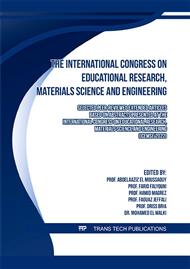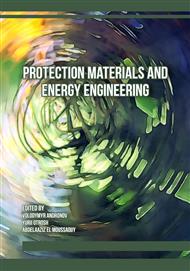[1]
R. Rapier, "Fossil fuels still supply 84 percent of world energy-and other eye openers from bp's annual review," Forbes https://www. forbes. com/sites/rrapier/2020/06/20/bp-review-newhighs-in-global-energy-consumption-and-carbon-emissions-in-2019, 2020.
Google Scholar
[2]
H.-O. Pörtner, D. C. Roberts, H. Adams, C. Adler, P. Aldunce, E. Ali, R. A. Begum, R. Betts, R. B. Kerr, R. Biesbroek, et al., Climate change 2022: Impacts, adaptation and vulnerability. IPCC Geneva, Switzerland:, 2022.
Google Scholar
[3]
M. Alaraj, A. Kumar, I. Alsaidan, M. Rizwan, and M. Jamil, "An advanced and robust approach to maximize solar photovoltaic power production," Sustainability, vol. 14, no. 12, p.7398, 2022.
DOI: 10.3390/su14127398
Google Scholar
[4]
A. Goodrich and M. Woodhouse, "A manufacturing cost analysis relevant to single-and dualjunction photovoltaic cells fabricated with iii-vs and iii-vs grown on czochralski silicon," tech. rep., National Renewable Energy Lab.(NREL), Golden, CO (United States), 2013.
DOI: 10.2172/1336550
Google Scholar
[5]
M. Wolf, "Limitations and possibilities for improvement of photovoltaic solar energy converters: Part i: Considerations for earth's surface operation," Proceedings of the IRE, vol. 48, no. 7, pp.1246-1263, 1960.
DOI: 10.1109/jrproc.1960.287647
Google Scholar
[6]
N. Das, H. Wongsodihardjo, and S. Islam, "A preliminary study on conversion efficiency improvement of a multi-junction pv cell with mppt," Smart Power Systems and Renewable Energy System Integration, pp.49-73, 2016.
DOI: 10.1007/978-3-319-30427-4_4
Google Scholar
[7]
A. Myllynen, T. Sadi, and J. Oksanen, "Current spreading in back-contacted gainp/gaas lightemitting diodes," IEEE Transactions on Electron Devices, vol. 67, no. 3, pp.1027-1033, 2020.
DOI: 10.1109/ted.2020.2964662
Google Scholar
[8]
M. Yamaguchi, "Iii-v compound multi-junction solar cells: present and future," Solar energy materials and solar cells, vol. 75, no. 1-2, pp.261-269, 2003.[9] M. Yamaguchi, "High-efficiency gaas-based solar cells," Post-Transition Metals, 2020.
DOI: 10.1016/s0927-0248(02)00168-x
Google Scholar
[10]
A. K. MI, K. Mehzabeen, and Z. Mahmood, "Study on the efficiency of the gainp2/gaas/ge multijunction solar cell," in Proc. of International Conference on Environmental Aspects of Bangladesh, BEN, Japan, pp.116-119, 2010.
Google Scholar
[11]
H. W. Yu, C. C. Chung, C. Te Wang, H. Q. Nguyen, B. T. Tran, K. L. Lin, C. F. Dee, B. Y. Majlis, and E. Y. Chang, "Ingap/gaas dual-junction solar cell with algaas/gaas tunnel diode grown on 10 off misoriented gaas substrate," Japanese Journal of Applied Physics, vol. 51, no. 8R, p.080208, 2012.
DOI: 10.1143/jjap.51.080208
Google Scholar
[12]
K. J. Singh and S. K. Sarkar, "Highly efficient arc less ingap/gaas dj solar cell numerical modeling using optimized inalgap bsf layers," Optical and Quantum Electronics, vol. 43, pp.1-21, 2012.
DOI: 10.1007/s11082-011-9499-y
Google Scholar
[13]
S. Sabri, R. Malek, and K. Kassmi, "Enhancement efficiency of solar cells based on quantum dots: A theoretical study," in Key Engineering Materials, vol. 927, pp.189-200, Trans Tech Publ, 2022.
DOI: 10.4028/p-vjscf6
Google Scholar
[14]
I. Tobias and A. Luque, "Ideal efficiency of monolithic, series-connected multijunction solar cells," Progress in Photovoltaics: Research and Applications, vol. 10, no. 5, pp.323-329, 2002.
DOI: 10.1002/pip.427
Google Scholar
[15]
K. Ali, H. Khan, M. Anmol, I. Ahmad, W. Farooq, B. Al-Asbahi, S. Qaid, H. Ghaithan, et al., "Effect of surface recombination velocity (srv) on the efficiency of silicon solar cell," Journal of Optoelectronics and Advanced Materials, vol. 22, no. May-June 2020, pp.251-255, 2020.
Google Scholar
[16]
T. Markvart and L. Castañer, "Semiconductor materials and modeling," in McEvoy's Handbook of Photovoltaics, pp.29-57, Elsevier, 2018.
DOI: 10.1016/b978-0-12-809921-6.00002-1
Google Scholar
[17]
J. Leem, Y. Lee, and J. Yu, "Optimum design of ingap/gaas dual-junction solar cells with different tunnel diodes," Optical and quantum electronics, vol. 41, pp.605-612, 2009.
DOI: 10.1007/s11082-010-9367-1
Google Scholar
[18]
M. Verma, S. R. Routray, and G. Mishra, "Analysis and optimization of bsf layer for highly efficient gainp single junction solar cell," Materials Today: Proceedings, vol. 43, pp.3420-3423, 2021.
DOI: 10.1016/j.matpr.2020.09.073
Google Scholar
[19]
B. Barman and P. Kalita, "Influence of back surface field layer on enhancing the efficiency of cigs solar cell," Solar Energy, vol. 216, pp.329-337, 2021.
DOI: 10.1016/j.solener.2021.01.032
Google Scholar
[20]
A. Kuddus, M. F. Rahman, S. Ahmmed, J. Hossain, and A. B. M. Ismail, "Role of facile synthesized v2o5 as hole transport layer for cds/cdte heterojunction solar cell: validation of simulation using experimental data," Superlattices and Microstructures, vol. 132, p.106168, 2019.
DOI: 10.1016/j.spmi.2019.106168
Google Scholar
[21]
X. Yang, B. Chen, J. Chen, Y. Zhang, W. Liu, and Y. Sun, "Zns thin film functionalized as back surface field in si solar cells," Materials Science in Semiconductor Processing, vol. 74, pp.309-312, 2018.
DOI: 10.1016/j.mssp.2017.08.011
Google Scholar
[22]
E. I. Ahamed, S. Bhowmik, M. Matin, and N. Amin, "Highly efficient ultra thin cu (in, ga) se 2 solar cell with tin selenide bsf," in 2017 International Conference on Electrical, Computer and Communication Engineering (ECCE), pp.428-432, IEEE, 2017.
DOI: 10.1109/ecace.2017.7912942
Google Scholar
[23]
F. Djaafar, B. Hadri, and G. Bachir, "Optimal parameters for performant heterojunction ingap/gaas solar cell," international journal of hydrogen energy, vol. 42, no. 13, pp.8644-8649, 2017.[24] Y. Wang, R. Zhang, Z. Zhang, B. Qiu, S. Wang, and X. Wu, "Efficiency improvement of gainp solar cells by broadband omnidirectional antireflection through dielectric composite nanostructures," Solar Energy Materials and Solar Cells, vol. 169, pp.33-39, 2017.
DOI: 10.1016/j.solmat.2017.04.025
Google Scholar
[25]
D. Friedman, J. Olson, and S. Kurtz, "High-efficiency iii-v multijunction solar cells," Handbook of Photovoltaic Science and Engineering, pp.314-364, 2010.
DOI: 10.1002/9780470974704.ch8
Google Scholar
[26]
G. Oh, Y. Kim, S. J. Lee, and E. K. Kim, "Broadband antireflective coatings for high efficiency ingap/gaas/ingaasp/ingaas multi-junction solar cells," Solar Energy Materials and Solar Cells, vol. 207, p.110359, 2020.
DOI: 10.1016/j.solmat.2019.110359
Google Scholar
[27]
J. F. Geisz, R. M. France, K. L. Schulte, M. A. Steiner, A. G. Norman, H. L. Guthrey, M. R. Young, T. Song, and T. Moriarty, "Six-junction iii-v solar cells with 47.1% conversion efficiency under 143 suns concentration," Nature energy, vol. 5, no. 4, pp.326-335, 2020.
DOI: 10.1038/s41560-020-0598-5
Google Scholar
[28]
S. Almosni, A. Delamarre, Z. Jehl, D. Suchet, L. Cojocaru, M. Giteau, B. Behaghel, A. Julian, C. Ibrahim, L. Tatry, et al., "Material challenges for solar cells in the twenty-first century: directions in emerging technologies," Science and Technology of advanced MaTerialS, vol. 19, no. 1, pp.336-369, 2018.
DOI: 10.1080/14686996.2018.1433439
Google Scholar
[29]
J. Piprek, Handbook of Optoelectronic Device Modeling and Simulation: Lasers, Modulators, Photodetectors, Solar Cells, and Numerical Methods, Vol. 2. CRC Press, 2017.
DOI: 10.4324/9781315152318
Google Scholar
[30]
K. Vyas, D. H. Espinosa, D. Hutama, S. K. Jain, R. Mahjoub, E. Mobini, K. M. Awan, J. Lundeen, and K. Dolgaleva, "Group iii-v semiconductors as promising nonlinear integrated photonic platforms," Advances in Physics: X, vol. 7, no. 1, p.2097020, 2022.
DOI: 10.1080/23746149.2022.2097020
Google Scholar
[31]
S. Sabri, R. Malek, and K. Kassmi, "A theoretical study of inas/inp and inas/gaas qds systems: Formation mechanisms and photoluminescence characterization," Materials Today: Proceedings, vol. 72, pp.3495-3501, 2023.
DOI: 10.1016/j.matpr.2022.08.158
Google Scholar
[32]
S. Adachi, "Iii-v ternary and quaternary compounds," Springer handbook of electronic and photonic materials, pp.1-1, 2017.
Google Scholar
[33]
H. Duan, J. Wang, and B. L. Karihaloo, "Theory of elasticity at the nanoscale," Advances in applied mechanics, vol. 42, pp.1-68, 2009.
Google Scholar
[34]
G. Marius, "The physics of semiconductors: An introduction including nanophysics and applications," 2016.
Google Scholar
[35]
J. W. Orton, The story of semiconductors. OUP Oxford, 2008.
Google Scholar
[36]
J. A. Nelson, The physics of solar cells. World Scientific Publishing Company, 2003.
Google Scholar
[37]
A. S. Brown and M. A. Green, "Impurity photovoltaic effect: Fundamental energy conversion efficiency limits," Journal of Applied Physics, vol. 92, no. 3, pp.1329-1336, 2002.
DOI: 10.1063/1.1492016
Google Scholar
[38]
T. Kirchartz and U. Rau, "What makes a good solar cell?," Advanced Energy Materials, vol. 8, no. 28, p.1703385, 2018.
DOI: 10.1002/aenm.201703385
Google Scholar
[39]
L. C. Hirst and N. J. Ekins-Daukes, "Fundamental losses in solar cells," Progress in Photovoltaics: Research and Applications, vol. 19, no. 3, pp.286-293, 2011.
DOI: 10.1002/pip.1024
Google Scholar
[40]
V. J. Chin, Z. Salam, and K. Ishaque, "Cell modelling and model parameters estimation techniques for photovoltaic simulator application: A review," Applied Energy, vol. 154, pp.500-519, 2015.[41] T. Markvart and L. Castañer, "Principles of solar cell operation," in McEvoy's Handbook of Photovoltaics, pp.3-28, Elsevier, 2018.
DOI: 10.1016/j.apenergy.2015.05.035
Google Scholar
[42]
P. Singh and N. M. Ravindra, "Temperature dependence of solar cell performance-an analysis," Solar energy materials and solar cells, vol. 101, pp.36-45, 2012.
DOI: 10.1016/j.solmat.2012.02.019
Google Scholar
[43]
S. Adachi, Properties of semiconductor alloys: group-IV, III-V and II-VI semiconductors. John Wiley & Sons, 2009.
Google Scholar



